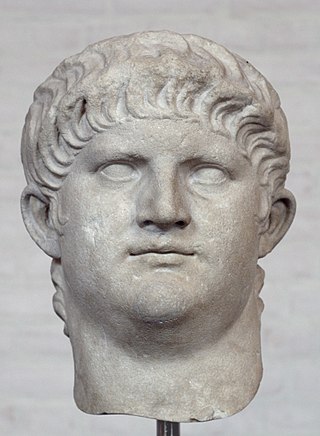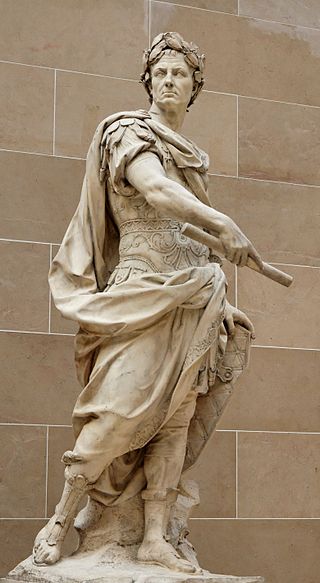
Nero Claudius Caesar Augustus Germanicus was a Roman emperor and the final emperor of the Julio-Claudian dynasty, reigning from AD 54 until his death in AD 68.

Gaius Plinius Secundus, called Pliny the Elder, was a Roman author, naturalist, natural philosopher, naval and army commander of the early Roman Empire, and a friend of the emperor Vespasian. He wrote the encyclopedic Naturalis Historia, which became an editorial model for encyclopedias. He spent most of his spare time studying, writing, and investigating natural and geographic phenomena in the field.

Marcus Licinius Crassus was a Roman general and statesman who played a key role in the transformation of the Roman Republic into the Roman Empire. He is often called "the richest man in Rome".

The following outline is provided as an overview of and topical guide to ancient Rome:

Nicomedia was an ancient Greek city located in what is now Turkey. In 286, Nicomedia became the eastern and most senior capital city of the Roman Empire, a status which the city maintained during the Tetrarchy system (293–324).

A fire department or fire brigade, also known as a fire company, fire authority, fire district, fire and rescue, or fire service in some areas, is an organization that provides fire prevention and fire suppression services as well as other rescue services.

The Domus Aurea was a vast landscaped complex built by the Emperor Nero largely on the Oppian Hill in the heart of ancient Rome after the great fire in 64 AD had destroyed a large part of the city.

The Great Fire of Rome began on the 18th of July 64 AD. The fire began in the merchant shops around Rome's chariot stadium, Circus Maximus. After six days, the fire was brought under control, but before the damage could be assessed, the fire reignited and burned for another three days. In the aftermath of the fire, 71% of Rome had been destroyed.

The vigintisexviri were a college (collegium) of minor magistrates in the Roman Republic. The college consisted of six boards:

In modern historiography, ancient Rome encompasses the founding of the Italian city of Rome in the 8th century BC, the Roman Kingdom, Roman Republic, Roman Empire, and the collapse of the Western Roman Empire in the 5th century AD.

Firefighting is a profession aimed at controlling and extinguishing fire. A person who engages in firefighting is known as a firefighter or fireman. Firefighters typically undergo a high degree of technical training. This involves structural firefighting and wildland firefighting. Specialized training includes aircraft firefighting, shipboard firefighting, aerial firefighting, maritime firefighting, and proximity firefighting.
Vigiles or more properly the Vigiles Urbani or Cohortes Vigilum were the firefighters and police of ancient Rome.
The ovation was a lesser form of the Roman triumph. Ovations were granted when war was not declared between enemies on the level of nations or states; when an enemy was considered basely inferior ; or when the general conflict was resolved with little or no danger to the army itself. The Ovation could also be given rather than a triumph when there were extenuating circumstances, such as when Marcus Marcellus was given an ovation in lieu of a triumph as his army remained in Sicily and therefore was unable to cross the pomerium.

The history of organized firefighting began in ancient Rome while under the rule of the first Roman Emperor Augustus. Prior to that, Ctesibius, a Greek citizen of Alexandria, developed the first fire pump in the third century BC, which was later improved upon in a design by Hero of Alexandria in the first century BC.
Ancient Romans with disabilities were recorded in the personal, medical, and legal writing of the period. While some disabled people were sought as slaves, others with disabilities that are now recognized by modern medicine were not considered disabled. Some disabilities were deemed more acceptable than others, either as honorable characteristics or as traits that increased morality. Small, scattered medical references contain the only direct acknowledgments of disability.
The praefectus vigilum was, starting with the reign of the Emperor Augustus, the commander of the city guards in Rome, whom were responsible for maintaining peace and order at night--a kind of fire and security police. Although less important than the other prefects, the office was considered a first step in order to reach an important position in the imperial administration.
The tresviri capitales or tresviri nocturni were one of the Vigintisexviri colleges in Ancient Rome. They were a group of three men that managed police and firefighting. Despite this they were feared by the Roman people due to their police roles, and they were condemned due to their neglect of firefighting during an unknown incident, which was likely the Great Fire of Rome. The Roman people gave the Tresviri Capitales the nickname nocturni due to the night patrols they managed. They were elected by the Urban praetors and later Tribal Assembly.
Marcus Egnatius Rufus was a Roman senator and politician at the time of Augustus.
Art collection in ancient Rome was a common practice amongst the ancient Romans. Goods and artworks had symbolic meanings and were used to convey messages about the collector and the Roman state. Due to the popularity of collectable goods an art market sprouted up. These goods were managed at first by the aediles and censors, and later by the curatores aedium sacrarum et operum locorumque. Lists may also have been used to track goods.

In the Roman Republic, triumviri or tresviri were special commissions of three men appointed for specific administrative tasks apart from the regular duties of Roman magistrates.












